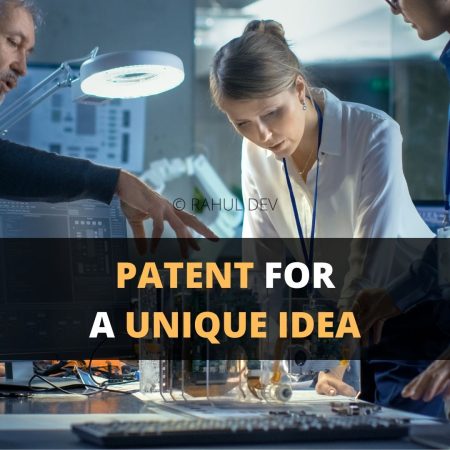New Innovative Ideas
Explore the Technology and Business Landscape

Understand Practical Aspects
Understand How Unique Ideas are Launched as Business Models

Explore the Technology and Business Landscape

Understand How Unique Ideas are Launched as Business Models

Protect your innovations across multiple countries and create strong patent portfolio to boost business valuation
Local and global brand protection through international trademark registrations
Extensive research and business writing for technical whitepapers and B2B content products
Innovative business ideas, and securing a patent for a new idea, are the lifeblood of successful enterprises, as exemplified by Groupon and Amazon. These companies transformed simple concepts into global phenomena, underscoring the importance of not only conceiving unique ideas through innovative business models but also effectively protecting them, including obtaining a patent for a new idea through unique aspects of its implementation. This article explores various strategies to safeguard such ideas, including securing patents for new ideas, from imitation or theft, ensuring their exclusive commercial use by the originator.

Patents are pivotal in protecting new inventions or processes, including patents for new ideas. A patent confers the exclusive right to exploit the invention, preventing others from manufacturing, selling, or using the patented item, including a patent for a new idea, without permission. Notable examples include Samsung, the world’s largest patent holder in 2022, demonstrating the significance of patents, including patents for new ideas, across sectors.
Trademarks protect unique symbols, names, or slogans associated with a brand, distinguishing it in the marketplace, and can be considered alongside patents for new ideas. Successful examples include Nike’s swoosh and Starbucks’ logo. Trademarks, with their roots in ancient artisan signatures, now play a crucial role in modern brand protection, comparable to patents for new ideas.
Copyrights defend the rights of creators over their works, encompassing literature, art, and even software, and can be sought in conjunction with patents for new ideas. This legal tool ensures creators maintain control over the reproduction and distribution of their original works, fostering innovation and creative expression, akin to obtaining a patent for a new idea.
Trade secrets cover information that provides a business with a competitive advantage, such as formulas or customer lists, and can be as crucial as securing a patent for a new idea. Maintaining the confidentiality of these secrets is vital for preserving their commercial value and exclusivity, similar to the protection offered by a patent for a new idea.
Non-Disclosure Agreements (NDAs) are critical in preventing the leakage of confidential information during business partnerships or employee engagements, just as a patent for a new idea protects inventions. Similarly, Non-Compete Agreements restrict employees or partners from engaging in competing ventures, thus protecting the core ideas and strategies of the business, which could include patents for new ideas. Also, Non-Solicitation Agreements prevent former employees from poaching clients or other employees, thereby safeguarding business relationships and trade secrets through various agreements and contracts, much like a patent for a new idea would.
The AI sector, particularly generative AI, faces a complex web of intellectual property challenges, including the need for patents for new ideas. For instance, Microsoft, GitHub, and OpenAI have faced a class action lawsuit for allegedly violating copyright laws through their AI system, Copilot, which is accused of using public code without proper attribution, highlighting the potential need for a patent for a new idea. Similarly, AI art tools like Midjourney and Stability AI have been sued for training their tools on web-scraped images, infringing on artists’ rights, which could have been mitigated by securing a patent for a new idea. One high-profile case involves Getty Images suing Stability AI for using its images without permission to train an art-generating AI, emphasizing the importance of a patent for a new idea in protecting against such disputes.
Blockchain technology offers innovative solutions for intellectual property management and protection, including patents for new ideas. Smart contracts, enabled by blockchain, provide a decentralized and immutable framework, revolutionizing the management of intellectual property assets, such as patents for new ideas. These applications range from IP licensing and royalty distribution to digital rights management systems. Blockchain can be used for decentralized IP registration and authentication, enabling more efficient and secure tracking of intellectual property rights, including patents for new ideas. Additionally, blockchain facilitates tokenization of IP assets, allowing for fractional ownership and more accessible IP transactions. The technology also supports smart contract automation for IP enforcement and dispute resolution, addressing privacy and security considerations in IP systems, much like a patent for a new idea.
The AI and blockchain sectors are reshaping the landscape of intellectual property protection. While AI brings challenges in defining and enforcing intellectual property rights, including the need for patents for new ideas, blockchain offers promising solutions for managing and protecting these rights. As the legal framework continues to evolve, businesses in these sectors must navigate a complex array of legal risks and opportunities, including obtaining patents for new ideas. They should adopt proactive strategies, including due diligence, legal consultation, and leveraging innovative technologies, to safeguard their intellectual property effectively, particularly through patents for new ideas.
Intellectual property (IP) is a key driver of innovation and competitive advantage in today’s global market. Developing and managing a robust IP strategy, encompassing both patent and trademark aspects, including securing patents for new ideas, is essential for businesses aiming to secure and capitalize on their innovations. While launching businesses embodying new and unique ideas, companies should conduct a preventive research analysis of the technological sector to identify risks and opportunities, aligning their patent strategy, including patents for new ideas, with their Product Life Cycle Management (PLCM) strategy. For example, in case of Smart Refrigerator Industry, an in-depth sector analysis helps identify areas for patenting, focusing on components and technologies with fewer patents and less prior art, and considering the importance of patents for new ideas.
Essentially, companies can focus on Patent Matrix Development by using tools like Patent Vault, companies can create a patent matrix, identifying key technology areas and components for patenting, including patents for new ideas. In terms of Strategic Patent Filing, it’s crucial to file patents in areas that are less crowded yet vital for the industry, categorizing them into primary, secondary, and tertiary patenting areas, which could include patents for new ideas. In use, visual tools assist in understanding market landscapes and identifying new patent opportunities, including patents for new ideas.
A preliminary review of International Trademark Systems recognizes the differences in trademark laws and processes among various jurisdictions is crucial, alongside considering patents for new ideas. The Madrid Protocol offers a streamlined process for international trademark registration, which can be parallel to obtaining patents for new ideas. For developing a strong trademark registration strategy, it is important to identify target markets, conduct trademark searches to avoid conflicts, and utilize international treaties for simplified processes, while also contemplating the acquisition of patents for new ideas. At the stage of trademark enforcement and vigilance, trademark owners continuously monitor and enforce trademark rights, updating the registration portfolio and engaging with local counsel for legal representation in target countries, in tandem with securing patents for new ideas.
The role played by patent valuation and trademark valuation during the launch of unique business models is to assess the quality and value of patents and trademarks, considering their impact on market position and potential for monetization, including the importance of patents for new ideas. Subsequently, for project valuation and business valuation, the goal is to evaluate the overall value of IP assets within the context of project and business valuation, incorporating them into the broader business strategy, and acknowledging the significance of patents for new ideas. Accordingly, an integrated approach to patent and trademark strategy, backed by data and market analysis, is essential for businesses to protect their innovations and enhance their market position, particularly by obtaining patents for new ideas. Strategic planning, continuous monitoring, and adaptation to market changes are key to maximizing the value of IP assets, including patents for new ideas.
When discussing new and unique business ideas, it becomes obvious that embracing tokenization and Web3 technologies offers novel opportunities for protecting and capitalizing on new ideas, including the use of patents for new ideas. Tokenization transforms assets into digital tokens on a blockchain, enhancing accessibility, liquidity, and reducing costs, much like the protection afforded by a patent for a new idea. The process involves asset selection, legal compliance, token creation, sale, and management, similar to the steps required in securing a patent for a new idea.
Also, obtaining a legal opinion on token classification is crucial for regulatory compliance, paralleling the process of acquiring a patent for a new idea. This involves understanding specific legal frameworks, like Malta’s VFA and Liechtenstein’s TT services, to ensure accurate classification and adherence to financial laws, akin to the process of securing a patent for a new idea. Subsequently, listing a token on an exchange like KuCoin requires comprehensive documentation, including a token legal opinion and a clear understanding of the exchange’s listing criteria, which can be compared to the diligence needed in patent applications for new ideas.
In addition, unique business ideas may also apply to Decentralized Autonomous Organizations (DAOs), which are online communities with shared crypto wallets, promoting decentralization, and democratic governance through blockchain technology, and may benefit from patents for new ideas. For DAO structuring best practices, it is essential to note that building a DAO begins with a shared vision, followed by establishing incentive alignment and community buy-in. DAOs require careful balancing of decentralization and efficiency through working groups or pods. In use, an effective DAO treasury management involves multisignature wallets and committees for transaction authorization, with tools like Gnosis Safe and Multisis for fund tracking and reporting, paralleling the protection provided by a patent for a new idea.
Web3 offers diverse business models, such as tokenized asset platforms, NFT marketplaces, and DeFi protocols. These models leverage blockchain technology for decentralized operations and community-driven governance. A token system aligns incentives among network participants, encouraging community growth and project success. Token economies are especially effective in DAOs with vibrant communities and active treasuries. Therefore, navigating the intricacies of token projects, DAOs, and Web3 models requires a strategic approach, focusing on legal compliance, transparent communication, and innovative use of blockchain technologies. By adopting these best practices, businesses can effectively protect and leverage their new ideas in the evolving digital landscape, including obtaining a patent for a new idea.
In the constantly shifting landscape of technology, utilizing diverse forms of strategic writing is an indispensable tool in safeguarding and championing novel concepts. B2B content writing aims to disseminate practical insights, foster brand visibility, boost conversions, and carve out a reputation as an industry authority. It’s a cost-efficient strategy that builds relationships, addresses the audience’s concerns, and enhances reach. In use, B2B Writing Varieties take multiple forms, including blog posts, white papers, press releases, product landing pages, and technical documents. Each serves distinct stages of the marketing funnel and caters to unique audience needs. Essential practices involve comprehending the marketing funnel, adhering to a coherent structure, utilizing clear and succinct language, incorporating narratives into the argument, maintaining flawless content, and continually evaluating strategies. Also, SEO-optimized content is essential for superior search rankings and amplified site traffic. This involves searching for pertinent keywords and maximizing the optimization of various forms of content, from blog posts to guides to case studies. Moreover, building a robust personal brand for executives involves crafting content that highlights their specialized knowledge and insights within their fields. This encompasses written articles, interviews, and active engagement within pertinent communities. It’s essential to customize technical content to the audience’s level of understanding, whether they are developers or end-users. Rigorous research and data gathering are pivotal to grasp the subject matter, particularly for intricate topics like AI and blockchain. Enhanced readability can be achieved through lucid language and well-structured formats, utilizing lists and logical clusters.
In conclusion, entrepreneurs favor a holistic approach to protect their unique business ideas, including obtaining a patent for a new idea. By leveraging patents, trademarks, copyrights, trade secrets, and legal agreements, businesses can secure their intellectual property, maintain their competitive edge, and ensure long-term success. Consulting with legal experts and continually reassessing the protection strategies are also crucial steps in this ongoing process. This comprehensive approach is fundamental for businesses to not only innovate but also to effectively protect and capitalize on their unique ideas in the increasingly competitive and dynamic global market.

As a business coach and thought leader, I cannot emphasize enough the importance of innovation, new software patents, mobile apps, and patents for tech companies, startups, and entrepreneurs. The world is rapidly evolving, and staying ahead of the curve is vital for success. Embracing technological advancements such as blockchain and AI can unlock unprecedented opportunities, streamline operations, and propel businesses into the future with competitive valuation via intangible assets.
Click Here for AI Startup Valuation Guide.
For instance, blockchain technology can revolutionize supply chain management and secure data sharing wherein innovative business models are explained to the audience via technical whitepapers, while AI can automate and optimize decision-making processes. Mobile apps are no longer just a luxury; they have become essential tools for engaging customers and offering personalized experiences. Furthermore, securing digital innovation patents is crucial for protecting intellectual property, fostering innovation, and maintaining a competitive edge. By investing in these areas, businesses can position themselves as industry pioneers and pave the way for a prosperous future after thoroughly conducting the due diligence and reviewing the legal opinion letters, which in case of digital assets can assist in determining the tokens as utility assets or coins as utility tokens before listing the assets at an exchange.
Our team of advanced patent attorneys assists clients with patent searches, drafting patent applications, and patent (intellectual property) agreements, including licensing and non-disclosure agreements. Advocate Rahul Dev is a Patent Attorney & International Business Lawyer practicing Technology, Intellectual Property & Corporate Laws. He is reachable at rd (at) patentbusinesslawyer (dot) com & @rdpatentlawyer on Twitter.
Quoted in and contributed to 50+ national & international publications (Bloomberg, FirstPost, SwissInfo, Outlook Money, Yahoo News, Times of India, Economic Times, Business Standard, Quartz, Global Legal Post, International Bar Association, LawAsia, BioSpectrum Asia, Digital News Asia, e27, Leaders Speak, Entrepreneur India, VCCircle, AutoTech).
Regularly invited to speak at international & national platforms (conferences, TV channels, seminars, corporate trainings, government workshops) on technology, patents, business strategy, legal developments, leadership & management.
Working closely with patent attorneys along with international law firms with significant experience with lawyers in Asia Pacific providing services to clients in US and Europe. Flagship services include international patent and trademark filings, patent services in India and global patent consulting services.
Global Blockchain Lawyers (www.GlobalBlockchainLawyers.com) is a digital platform to discuss legal issues, latest technology and legal developments, and applicable laws in the dynamic field of Digital Currency, Blockchain, Bitcoin, Cryptocurrency and raising capital through the sale of tokens or coins (ICO or Initial Coin Offerings).
Blockchain ecosystem in India is evolving at a rapid pace and a proactive legal approach is required by blockchain lawyers in India to understand the complex nature of applicable laws and regulations.